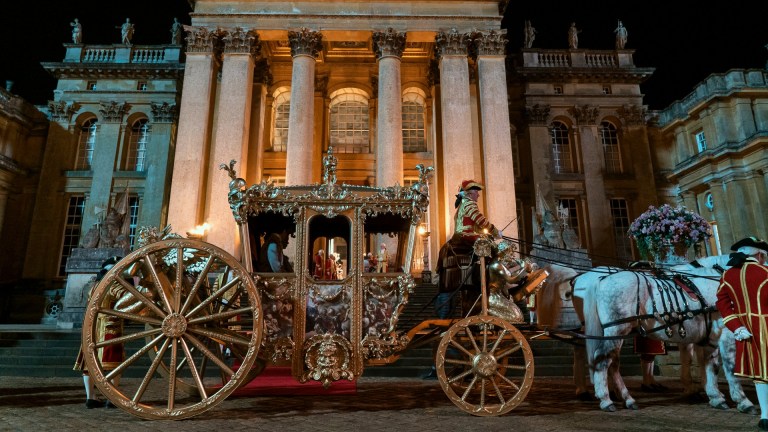Bridgerton: The Real History of Queen Charlotte, and King George III’s Illness
How much does Queen Charlotte: A Bridgerton Story borrow from the real life monarchy? More than you might think.

This article contains spoilers for all episodes of Queen Charlotte: A Bridgerton Story.
Netflix’s new limited series Queen Charlotte: A Bridgerton Story is being described by many as a spinoff but in fact, the six-episode season can be considered a fully developed interlude bridging the gap between Bridgerton seasons 2 and 3. The show is set as a prequel to cover the early days of Charlotte and George’s marriage combined with a view of how their family is faring in the current series timeline.
Showrunner Shonda Rhimes has combined some elements of the actual Queen’s history with explanations of how the world of Bridgerton’s Ton is different than the historical record. Folks interested in history should keep in mind the focus of the miniseries is to explain the character development and politics of the characters Bridgerton fans are already familiar with. Anyone claiming the miniseries is “erasing history” refuses to understand why diverse period drama depictions exist and are missing the point.
The Royal Court & The “Great Experiment”
Officially, King George III ascended the throne in 1760 and married Sophia Charlotte of Mecklenburg-Strelitz (a territory in northern Germany) in 1761. Queen Charlotte’s brother Adolphus exists as well but he is known by Federick Augustus in history. Charlotte speaks perfect English in Queen Charlotte but in real life, she did not and had to learn English and the customs of a new country.
The Dowager Princess Augusta and Lord Bute were prominent figures in the early days of King George III’s reign. However, The conversational references to wars and taxation line up with the Seven Years’ War against the French during this time period and the beginnings of the American Revolution. The concern about King George III and Queen Charlotte having heirs as quickly as possible is also out of history. This is why their marriage was arranged in the first place.
Since Bridgerton has fully embraced the theories that Queen Charlotte has possible African ancestry, Queen Charlotte takes time to clarify the Bridgerton season 1 reference to Charlotte and George’s marriage unifying the white members of the Ton and the BIPOC elites. Events such as Lord Danbury mentioning that he was initially denied entrance to the gentleman’s club reveal that equity and inclusion were not an overnight process. White Ton members in particular had to make changes in their mindset and actions. These developments not only explain to viewers the way the world of Bridgerton works but also justify current and future culturally conscious and racebent character casting.
The Danbury family and their title are entirely fictional but there is one grain of truth in their story: the Kpa-Mende Bo is a clan of the Mende people. Queen Charlotte however uses Sierra Leone as the name of the country which was not officially in existence until the UK set up their colony in the region in 1808. An argument can be made that this anachronism is designed to give viewers an easy modern-day reference and another can be made that Bridgerton’s world-building picks and chooses which aspect of the UK’s empire history to highlight based on story expedience.
There is no historical example of a person of color in Lady Danbury’s position defending the right to inherit royal titles in this era, however, we do know Black British people were allowed to inherit goods and property. As other period drama series like Sanditon depict, Black heirs and heiresses who inherited money or property from the Caribbean and other colonies could very well have white relatives legally challenge the wills which declared them heirs.
The uneasiness of the white members of the Ton had with beginning to interact with BIPOC Ton members shares thematic similarities with the end of legal and social segregation in the US and social segregation in the UK but this storyline is also entirely only in the annals of Bridgerton history.
King George’s Illness
Bridgerton fans have already seen King George III in a confused way. Queen Charlotte shows how George suffered from hearing voices in his head even before Charlotte was sent to marry him. Dr. John Monro from the Bethlem Hospital existed in history and so did the institution he represented. Monro advocated cold water baths for patient treatment and other forms of hydrotherapy. The Bethlem Royal Hospital was first founded as a Catholic church priory in 1247 but didn’t evolve into a place specializing in the treatment of the mentally ill until the mid-1400s. After the Reformation, the leadership of the hospital was turned from control by church officials over to control by the City Of London. Management positions were appointed by the Crown and were frequently used to reward wealthy patrons.
In terms of the plot, the first recorded instance of King George III’s illness was around 1765, well after he was married. It is historically plausible earlier episodes were hidden from public knowledge. Experts today believe King George III had bipolar disorder. Rhimes’ depiction of repeat dunkings in cold water and other treatments are dramatizations of the fact that medical professionals of the age didn’t know how to treat mental illness.
Where the series definitely veers toward fiction is depicting Charlotte as a wife who advocated against the medical establishments’ more radical methods of treating the mentally ill. There is not enough historical evidence to support whether Queen Charlotte ever personally confronted Monro or other doctors who attempted to treat King George III.
“Deformed Bunny”
Charlotte’s beloved Pomeranians in Bridgerton have an interesting backstory. Queen Charlotte puts forth that the first one was the result of George taking one of Dr. Monro’s animal test subjects from the laboratory to give as a gift to Charlotte. Pomeranians are indeed German in origin but they were bred from bigger sled dogs thousands of years after wild wolves evolved into domestic dogs. This version of the history of pomeranians is clearly about highlighting George and Charlotte learning to trust and love each other.
The Succession Crisis
Charlotte in the current timeline fears for the future of the royal family. Her daughters refuse to marry and her sons have had many babies outside of wedlock. This is indeed based on history.
Queen Charlotte finally introduces viewers to the person the Regency Era was named after Prince George IV. He was installed as Regent in 1811 after King George was ruled too ill to continue to rule Britain. In fact, Queen Charlotte also introduces to the audience Queen Victoria’s parents: Prince Edward and Princess Victoria. She inherited the crown in the first place because her father was not the firstborn son and was the first legitimate descendant of King George III.
Queen Charlotte will be far from the last period drama to draw from biographies to create an alternate historical timeline for the purposes of entertainment. Good period dramas encourage the audience to do their own research. On the other hand, people who spend all day researching history should try to enjoy period dramas despite their imperfections with the facts.
All six episodes of Queen Charlotte: A Bridgerton Story are available to stream on Netflix now.
